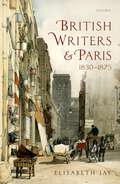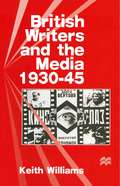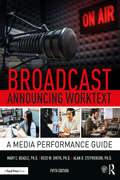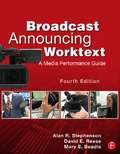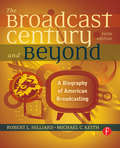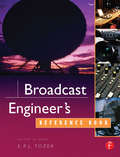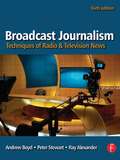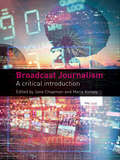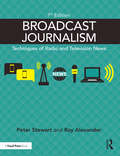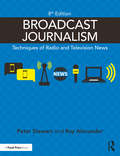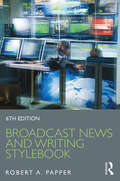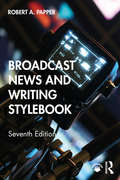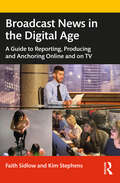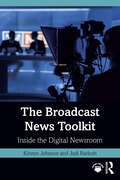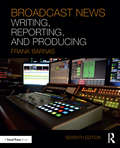- Table View
- List View
British Writers and Paris: 1830-1875
by Elisabeth Jay'A wicked and detestable place, though wonderfully attractive': Charles Dickens's conflicted feelings about Paris typify the fascination and repulsion with which a host of mid-nineteenth-century British writers viewed their nearest foreign capital. Variously perceived as the showcase for sophisticated, cosmopolitan talent, the home of revolution, a stronghold of Roman Catholicism, and a shrine to irreligious hedonism, Paris was also a city where writers were respected and journalism flourished. This historically-grounded account of the ways in which Paris touched the careers and work of both major and minor Victorian writers considers both their actual experiences of an urban environment, distinctively different from anything Britain offered, and the extent to which this became absorbed and expressed within the Victorian imaginary. Casting a wide literary net, the first part of this book explores these writers' reaction to the swiftly changing politics and topography of Paris, before considering the nature of their social interactions with the Parisians, through networks provided by institutions such as the British Embassy and the salons. The second part of the book examines the significance of Paris for mid-nineteenth-century Anglophone journalists., paying particular attention to the ways in which the young Thackeray's exposure to Parisian print culture shaped him as both writer and artist. The final part focuses on fictional representations of Paris, revealing the frequency with which they relied upon previous literary sources, and how the surprisingly narrow palette of subgenres, structures and characters they employed contributed to the characteristic, and sometimes contradictory, prejudices of a swiftly-growing British readership.
British Writers and the Media, 1930–45
by Keith WilliamsRichly informative about a host of writers from Auden to Priestley, and theoretically informed, this wide-ranging new study demonstrates that the 1930s, remembered usually for uncomplicated political engagement, can rather be seen as initiating the key elements of postmodernism, developing the individual's sense of `elsewhere' through new technology of representation and propaganda. Keith Williams analyses the relationship between the leftist writers of the decade and the mass-media, showing how newspapers, radio and film were treated in their writing and how they radically reshaped its forms, assumptions and imagery.
Broadcast Announcing Worktext: A Media Performance Guide
by Alan R. Stephenson Reed Smith Mary E. BeadleBroadcast Announcing Worktext, now in its fifth edition, remains one of the best resources for those looking to gain the skills, techniques, and procedures necessary to enter the competitive field of broadcast performance. Written accessibly, with easy-to-digest modules and practice projects, this book encourages active participation from readers to help develop their talent on air. In addition to the principles of good performance, the book addresses the importance of the audience and how to communicate effectively to diverse groups. The book combines traditional teaching with practical experience, and includes sample scripts and self-study exercises to allow for a practical, hands-on application of key concepts. The fifth edition, expanded throughout, features updates about performance on the Internet and social media, as well as content about podcasting and audio performance. A new chapter on international media offers readers a look at media performance and career possibilities around the world. This book is an invaluable resource for any student of journalism, communication, or public relations looking to enhance their media performance skills. A detailed accompanying website features audio-clips, sample test questions, and a Professionals’ Comment Bank setting out experience and advice from working pros.
Broadcast Announcing Worktext: A Media Performance Guide
by Alan R. Stephenson Reed Smith Mary E. BeadleBroadcast Announcing Worktext, now in its fifth edition, remains one of the best resources for those looking to gain the skills, techniques, and procedures necessary to enter the competitive field of broadcast performance. Written accessibly, with easy-to-digest modules and practice projects, this book encourages active participation from readers to help develop their talent on air. In addition to the principles of good performance, the book addresses the importance of the audience and how to communicate effectively to diverse groups. The book combines traditional teaching with practical experience, and includes sample scripts and self-study exercises to allow for a practical, hands-on application of key concepts. The fifth edition, expanded throughout, features updates about performance on the Internet and social media, as well as content about podcasting and audio performance. A new chapter on international media offers readers a look at media performance and career possibilities around the world. This book is an invaluable resource for any student of journalism, communication, or public relations looking to enhance their media performance skills. A detailed accompanying website features audio-clips, sample test questions, and a Professionals’ Comment Bank setting out experience and advice from working pros.
Broadcast Announcing Worktext: A Media Performance Guide
by Alan Stephenson David Reese Mary BeadleThe Broadcast Announcing Worktext provides you with the skills, techniques, and procedures necessary to enter this highly competitive field of broadcast performance. In addition to the principles of good performance, this book addresses the importance of audience and how to communicate effectively to various groups. Television and radio studio environments, announcer specializations and responsibilities, and developing a broadcast delivery style are just a few of the many topics covered. Factual information is presented in brief, easy-to-digest modules and is enhanced with self-study questions and projects. The self-study provides an immediate check on what you learn, and the projects allow for a practical hands-on application of key concepts in the material. The worktext format, with many real-life examples, combines both traditional teaching and practical experience. A companion CD illustrates techniques and concepts in each chapter with audio and visual examples. This third edition will give you knowledge of other non-traditional forms of announcing, such as online radio announcing, podcast announcing, and other forms of online announcing, such as online shows, clips, and news.
Broadcast Announcing Worktext: A Media Performance Guide
by Alan Stephenson David Reese Mary BeadleThe Broadcast Announcing Worktext provides you with the skills, techniques, and procedures necessary to enter this highly competitive field of broadcast performance. In addition to the principles of good performance, this book addresses the importance of audience and how to communicate effectively to various groups. Television and radio studio environments, announcer specializations and responsibilities, and developing a broadcast delivery style are just a few of the many topics covered. Factual information is presented in brief, easy-to-digest modules and is enhanced with self-study questions and projects. The self-study provides an immediate check on what you learn, and the projects allow for a practical hands-on application of key concepts in the material. The worktext format, with many real-life examples, combines both traditional teaching and practical experience. A companion CD illustrates techniques and concepts in each chapter with audio and visual examples. This third edition will give you knowledge of other non-traditional forms of announcing, such as online radio announcing, podcast announcing, and other forms of online announcing, such as online shows, clips, and news.
The Broadcast Century and Beyond: A Biography of American Broadcasting
by Robert L Hilliard Michael C KeithThe Broadcast Century and Beyond is a popular history of the most influential and innovative industry of the century. The story of broadcasting is told in a direct and informal style, blending personal insight and authoritative scholarship to fully capture the many facets of this dynamic industry. The book vividly depicts the events, people, programs, and companies that made television and radio dominant forms of communication. The latest edition includes coverage of all the technologies that have emerged over the past decade and discusses the profound impact they have had on the broadcasting industry in political, social, and economic spheres. "Broadcasting" as a whole has been completely revolutionized with the advent of YouTube, podcasting, iphones, etc, and the authors show how this closing of world-wide broadcasting channels affects the industry.
The Broadcast Century and Beyond: A Biography of American Broadcasting
by Robert L Hilliard Michael C KeithThe Broadcast Century and Beyond is a popular history of the most influential and innovative industry of the century. The story of broadcasting is told in a direct and informal style, blending personal insight and authoritative scholarship to fully capture the many facets of this dynamic industry. The book vividly depicts the events, people, programs, and companies that made television and radio dominant forms of communication. The latest edition includes coverage of all the technologies that have emerged over the past decade and discusses the profound impact they have had on the broadcasting industry in political, social, and economic spheres. "Broadcasting" as a whole has been completely revolutionized with the advent of YouTube, podcasting, iphones, etc, and the authors show how this closing of world-wide broadcasting channels affects the industry.
Broadcast Engineer's Reference Book
by E.P.J. TozerThe current and definitive reference broadcast engineers need!Compiled by leading international experts, this authoritative reference work covers every aspect of broadcast technology from camera to transmitter - encompassing subjects from analogue techniques to the latest digital compression and interactive technologies in a single source.Written with a minimum of maths, the book provides detailed coverage and quick access to key technologies, standards and practices. This global work will become your number one resource whether you are from an audio, video, communications or computing background. Composed for the industry professional, practicing engineer, technician or sales person looking for a guide that covers the broad landscape of television technology in one handy source, the Broadcast Engineer's Reference Book offers comprehensive and accurate technical information. Get this wealth of information at your fingertips!· Utilize extensive illustrations-more than 1200 tables, charts and photographs.· Find easy access to essential technical and standards data.· Discover information on every aspect of television technology.· Learn the concepts and terms every broadcaster needs to know.Learn from the experts on the following technologies:Quantities and Units; Error Correction; Network Technologies; Telco Technologies; Displays; Colourimetry; Audio Systems; Television Standards; Colour encoding; Time code; VBI data carriage; Broadcast Interconnect formats; File storage formats; HDTV; MPEG 2; DVB; Data Broadcast; ATSC Interactive TV; encryption systems; Optical systems; Studio Cameras and camcorders; VTRs and Tape Storage; Standards Convertors; TV Studios and Studio Equipment; Studio Lighting and Control; post production systems; Telecines; HDTV production systems; Media Asset Management systems; Electronic News Production Systems; OB vehicles and Mobile Control Rooms;ENG and EFP; Power and Battery Systems; R.F. propagation; Service Area Planning; Masts Towers and Antennas; Test and measurement; Systems management; and many more!Related Focal Press titles:Watkinson: Convergence In Broadcast and Communications Media (2001, £59.99 (GBP)/ $75.95 (USD), ISBN: 0240515099) Watkinson: MPEG Handbook (2001, £35 (GBP)/$54.99 (USD) ISBN: 0240516567)
Broadcast Engineer's Reference Book
by E. P. J. TozerThe current and definitive reference broadcast engineers need!Compiled by leading international experts, this authoritative reference work covers every aspect of broadcast technology from camera to transmitter - encompassing subjects from analogue techniques to the latest digital compression and interactive technologies in a single source.Written with a minimum of maths, the book provides detailed coverage and quick access to key technologies, standards and practices. This global work will become your number one resource whether you are from an audio, video, communications or computing background. Composed for the industry professional, practicing engineer, technician or sales person looking for a guide that covers the broad landscape of television technology in one handy source, the Broadcast Engineer's Reference Book offers comprehensive and accurate technical information. Get this wealth of information at your fingertips!· Utilize extensive illustrations-more than 1200 tables, charts and photographs.· Find easy access to essential technical and standards data.· Discover information on every aspect of television technology.· Learn the concepts and terms every broadcaster needs to know.Learn from the experts on the following technologies:Quantities and Units; Error Correction; Network Technologies; Telco Technologies; Displays; Colourimetry; Audio Systems; Television Standards; Colour encoding; Time code; VBI data carriage; Broadcast Interconnect formats; File storage formats; HDTV; MPEG 2; DVB; Data Broadcast; ATSC Interactive TV; encryption systems; Optical systems; Studio Cameras and camcorders; VTRs and Tape Storage; Standards Convertors; TV Studios and Studio Equipment; Studio Lighting and Control; post production systems; Telecines; HDTV production systems; Media Asset Management systems; Electronic News Production Systems; OB vehicles and Mobile Control Rooms;ENG and EFP; Power and Battery Systems; R.F. propagation; Service Area Planning; Masts Towers and Antennas; Test and measurement; Systems management; and many more!Related Focal Press titles:Watkinson: Convergence In Broadcast and Communications Media (2001, £59.99 (GBP)/ $75.95 (USD), ISBN: 0240515099) Watkinson: MPEG Handbook (2001, £35 (GBP)/$54.99 (USD) ISBN: 0240516567)
Broadcast Journalism: Techniques of Radio and Television News (6th edition) (PDF)
by Andrew Boyd Peter Stewart Ray AlexanderThis newest edition of Broadcast Journalism continues its long tradition of covering the basics of broadcasting from gathering news sources, interviewing, putting together a programme, news writing, reporting, editing, working in the studio, conducting live reports, and more. Two new authors have joined forces in this new edition to present behind the scenes perspectives on multimedia broadcast news, where it is heading, and how you get there.
Broadcast Journalism: A Critical Introduction
by Jane Chapman Marie KinseyBroadcast Journalism offers a critical analysis of the key skills required to work in the modern studio, on location, or online, with chapters written by industry professionals from the BBC, ITV, CNN and independent production companies in the UK and USA. Areas highlighted include: interviewing researching editing writing reporting. The practical tips are balanced with chapters on representation, ethics, law, economics and history, as well as specialist areas such as documentary and the reporting of politics, business, sport and celebrity. Broadcast Journalism concludes with a vital chapter on career planning to act as a springboard for your future work in the broadcast industry. Contributors: Jim Beaman; Jane Chapman; Fiona Chesterton; Tim Crook; Anne Dawson; Tony Harcup; Jackie Harrison; Ansgard Heinrich; Emma Hemmingway; Patricia Holland; David Holmes; Gary Hudson; Nicholas Jones; Marie Kinsey; Roger Laughton; Leslie Mitchell; Jeremy Orlebar; Claire Simmons; Katie Stewart; Ingrid Volkmer; Mike Ward; Deborah Wilson.
Broadcast Journalism: A Critical Introduction
by Jane Chapman Marie KinseyBroadcast Journalism offers a critical analysis of the key skills required to work in the modern studio, on location, or online, with chapters written by industry professionals from the BBC, ITV, CNN and independent production companies in the UK and USA. Areas highlighted include: interviewing researching editing writing reporting. The practical tips are balanced with chapters on representation, ethics, law, economics and history, as well as specialist areas such as documentary and the reporting of politics, business, sport and celebrity. Broadcast Journalism concludes with a vital chapter on career planning to act as a springboard for your future work in the broadcast industry. Contributors: Jim Beaman; Jane Chapman; Fiona Chesterton; Tim Crook; Anne Dawson; Tony Harcup; Jackie Harrison; Ansgard Heinrich; Emma Hemmingway; Patricia Holland; David Holmes; Gary Hudson; Nicholas Jones; Marie Kinsey; Roger Laughton; Leslie Mitchell; Jeremy Orlebar; Claire Simmons; Katie Stewart; Ingrid Volkmer; Mike Ward; Deborah Wilson.
Broadcast Journalism: Techniques of Radio and Television News
by Peter Stewart Ray AlexanderThis seventh edition of Broadcast Journalism continues its long tradition of covering the basics of broadcasting from gathering news sources, interviewing, putting together a programme, news writing, reporting, editing, working in the studio, conducting live reports and more. The authors have brought the material further up to date with the integration of social media, uses of mobile technology, the emergence of user-generated content and updated examples, illustrations and case studies throughout. End-of-chapter exercises are also included. New for this edition: Updated with new examples, quotes and pictures. Restructured with end-of-chapter summaries, exercises for students, notes for tutors, links for further reading and references to invaluable websites and smartphone apps. Extended chapters on ethics, responsibilities, interviewing, mobile newsgathering and filming. New additional information on coping with reporting traumatic stories, and how news organisations use Twitter and Periscope.
Broadcast Journalism: Techniques of Radio and Television News
by Peter Stewart Ray AlexanderThis seventh edition of Broadcast Journalism continues its long tradition of covering the basics of broadcasting from gathering news sources, interviewing, putting together a programme, news writing, reporting, editing, working in the studio, conducting live reports and more. The authors have brought the material further up to date with the integration of social media, uses of mobile technology, the emergence of user-generated content and updated examples, illustrations and case studies throughout. End-of-chapter exercises are also included. New for this edition: Updated with new examples, quotes and pictures. Restructured with end-of-chapter summaries, exercises for students, notes for tutors, links for further reading and references to invaluable websites and smartphone apps. Extended chapters on ethics, responsibilities, interviewing, mobile newsgathering and filming. New additional information on coping with reporting traumatic stories, and how news organisations use Twitter and Periscope.
Broadcast Journalism: Techniques of Radio and Television News
by Peter Stewart Ray AlexanderNow in its 8th edition, Broadcast Journalism continues to be an essential text on the production of news broadcasting and the practical skills needed. It includes not only basic techniques and classic examples for the production of radio and TV news, but also new technology and the latest case studies. The fundamental skills of interviewing, news writing and production now have to cope with the prevalence of Fake News and Deep Fakes and verifying content in an endless flow of social media. This edition also includes newsgathering with mobile devices, live reporting and using data and graphics. There are dozens of new images and links for downloads and further reading, plus end-of-chapter exercises and tutor notes. This continues to be an indispensable textbook for broadcast journalism and communications students looking for an in-depth guide to the industry.
Broadcast Journalism: Techniques of Radio and Television News
by Peter Stewart Ray AlexanderNow in its 8th edition, Broadcast Journalism continues to be an essential text on the production of news broadcasting and the practical skills needed. It includes not only basic techniques and classic examples for the production of radio and TV news, but also new technology and the latest case studies. The fundamental skills of interviewing, news writing and production now have to cope with the prevalence of Fake News and Deep Fakes and verifying content in an endless flow of social media. This edition also includes newsgathering with mobile devices, live reporting and using data and graphics. There are dozens of new images and links for downloads and further reading, plus end-of-chapter exercises and tutor notes. This continues to be an indispensable textbook for broadcast journalism and communications students looking for an in-depth guide to the industry.
Broadcast News and Writing Stylebook
by Robert A. PapperPapper’s Broadcast News and Writing Stylebook is the go-to handbook in broadcast news, and with the updates in the 6th edition, it is sure to continue this legacy. Through clear and concise chapters, this text provides the fundamental rules of broadcast news writing. It covers various fields across the board, including crime and government, weather, education, health, and sports. Within each field, readers learn the nuances of reporting, grammar, style, and usage. Written by a professional who has overseen major industry research for the past 23 years, this edition presents the data on news writing in a relevant and digestible manner. With the business of broadcast news changing rapidly, this text reflects the current news environment and explores where it will head in the future. With an expanded social media chapter and additional insight into the news rooms of today, Broadcast News and Writing Stylebook incorporates all the skills and knowledge reporters and journalist need to prepare for their careers.
Broadcast News and Writing Stylebook
by Robert A. PapperBroadcast News and Writing Stylebook is the go-to resource for writing broadcast news, offering readers the know-how to write excellent stories for television, radio, podcasts and online media. Through clear and concise chapters, this text provides the fundamental rules of broadcast news writing, teaching readers how to craft stories on government, crime, weather, education, health, sports and more. It covers the necessary mechanics news writers need to know, including the nuances of reporting, grammar, style and usage. This new seventh edition is updated with the latest on how stations incorporate online and social media strategies, as well as insights into the directions local news is headed. Author Robert A. Papper has over a quarter century of broadcast news and industry research experience and once again updates this vital text with the information necessary for being a successful news writer today. Also available for this edition is an Instructor’s Guide, found on the book’s webpage. Whether you’re a student seeking to learn the mechanics of successful broadcast news writing or a working professional looking for a definitive reference for your desk, Broadcast News and Writing Stylebook offers a comprehensive guide to writing for television, audio and beyond.
Broadcast News and Writing Stylebook
by Robert A. PapperBroadcast News and Writing Stylebook is the go-to resource for writing broadcast news, offering readers the know-how to write excellent stories for television, radio, podcasts and online media. Through clear and concise chapters, this text provides the fundamental rules of broadcast news writing, teaching readers how to craft stories on government, crime, weather, education, health, sports and more. It covers the necessary mechanics news writers need to know, including the nuances of reporting, grammar, style and usage. This new seventh edition is updated with the latest on how stations incorporate online and social media strategies, as well as insights into the directions local news is headed. Author Robert A. Papper has over a quarter century of broadcast news and industry research experience and once again updates this vital text with the information necessary for being a successful news writer today. Also available for this edition is an Instructor’s Guide, found on the book’s webpage. Whether you’re a student seeking to learn the mechanics of successful broadcast news writing or a working professional looking for a definitive reference for your desk, Broadcast News and Writing Stylebook offers a comprehensive guide to writing for television, audio and beyond.
Broadcast News in the Digital Age: A Guide to Reporting, Producing and Anchoring Online and on TV
by Faith M Sidlow Kim StephensWritten by two award-winning broadcast journalists, this book offers a practical, hands-on guide to the modern digital TV newsroom. Pulling from extensive industry experience, the authors provide a comprehensive look at the key journalistic skills needed to excel in broadcast news today, including storytelling, writing, story pitching, video production, interviewing and managing social media. The textbook is organized into five sections: building a foundation, storytelling and writing, producing, live performance, and ethics and career progression. The authors also provide step-by-step instructions on how to efficiently multitask while staying true to journalist ethics. Each chapter includes clear learning objectives, review questions and practical assignments, making it ideal for classroom use. QR codes integrated in the text allow students to easily see and hear examples of the stories they are learning to write. Broadcast News in the Digital Age is an engaging, student-friendly guide for those seeking to become successful writers, producers, anchors and journalists in today’s newsrooms, both on-air and online.
Broadcast News in the Digital Age: A Guide to Reporting, Producing and Anchoring Online and on TV
by Faith M Sidlow Kim StephensWritten by two award-winning broadcast journalists, this book offers a practical, hands-on guide to the modern digital TV newsroom. Pulling from extensive industry experience, the authors provide a comprehensive look at the key journalistic skills needed to excel in broadcast news today, including storytelling, writing, story pitching, video production, interviewing and managing social media. The textbook is organized into five sections: building a foundation, storytelling and writing, producing, live performance, and ethics and career progression. The authors also provide step-by-step instructions on how to efficiently multitask while staying true to journalist ethics. Each chapter includes clear learning objectives, review questions and practical assignments, making it ideal for classroom use. QR codes integrated in the text allow students to easily see and hear examples of the stories they are learning to write. Broadcast News in the Digital Age is an engaging, student-friendly guide for those seeking to become successful writers, producers, anchors and journalists in today’s newsrooms, both on-air and online.
The Broadcast News Toolkit: Inside the Digital Newsroom
by Kirsten Johnson Jodi RadoshThe Broadcast News Toolkit focuses on the writing, shooting, and production of broadcast news across multimedia platforms in a non-technical and visually engaging way. Covering a range of different story forms in broadcast news (RDR, FS, VO, VO/SOT, PKG, and Liveshots), this book illustrates basic audio/video shooting and editing techniques through straightforward examples, including online video tutorials that can be accessed via a QR code within the book. Specific issues relating to online content, social media, and audience engagement are discussed in detail, and the authors further explore why trust in news media is declining, the impact that fake news and deep fake videos have on media credibility in newsrooms, and what can be done to increase the perceived credibility of the news. Students will also learn how to write leads and teases that will keep viewers engaged. This is an ideal text for undergraduate and graduate students of Broadcast and Multimedia Journalism who are looking for a clear and concise guide to the modern digital newsroom.
The Broadcast News Toolkit: Inside the Digital Newsroom
by Kirsten Johnson Jodi RadoshThe Broadcast News Toolkit focuses on the writing, shooting, and production of broadcast news across multimedia platforms in a non-technical and visually engaging way. Covering a range of different story forms in broadcast news (RDR, FS, VO, VO/SOT, PKG, and Liveshots), this book illustrates basic audio/video shooting and editing techniques through straightforward examples, including online video tutorials that can be accessed via a QR code within the book. Specific issues relating to online content, social media, and audience engagement are discussed in detail, and the authors further explore why trust in news media is declining, the impact that fake news and deep fake videos have on media credibility in newsrooms, and what can be done to increase the perceived credibility of the news. Students will also learn how to write leads and teases that will keep viewers engaged. This is an ideal text for undergraduate and graduate students of Broadcast and Multimedia Journalism who are looking for a clear and concise guide to the modern digital newsroom.
Broadcast News Writing, Reporting, and Producing
by Frank BarnasBroadcast News Writing, Reporting, and Producing, 7th Edition is the leading book covering all aspects of writing and reporting the news. It identifies the key concepts and terms readers need to know in the news gathering and dissemination process, and provides practical, real-world advice for operating in the modern day newsroom. New to the seventh Edition are profiles of working journalists who give readers a glimpse into the working life of modern reporters, producers, and directors. This new edition also covers important aspects of the use of social media, drone journalism, and digital technology. A new chapter on portfolio development will assist readers in developing the skills to advance in their careers. The text has also been updated to reflect new industry standards in modes of information gathering and delivery, writing style, and technology. Additional features include: Key words at the start of every chapter, identifying important terms and definitions; End of chapter summaries, which allows readers to review the chapter’s main points; "Text Your Knowledge", which helps readers quiz themselves on important concepts; Chapter-by-chapter exercises, which readers can apply to a chapter’s themes; A companion website featuring video tutorials of necessary skills for journalists, including how to arrange lighting structures, how to hold a microphone, and how to properly conduct an interview.
